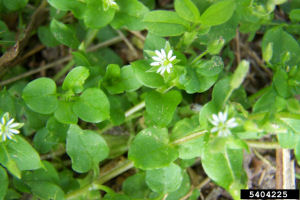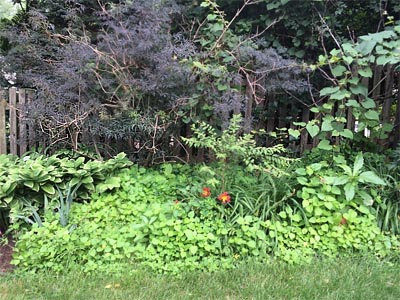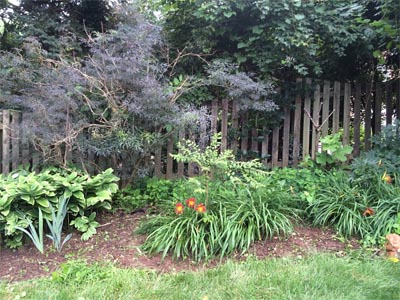How to Reclaim Your Garden in 15 Minutes a Day
By Martha Brettshneider, Fairfax Master Gardener
Gardening vs. life: It’s a constant push-pull for most of us. Some years you have plenty of time and energy to devote to the garden, some years you have hardly any at all.
Spring gardening is usually sacrosanct for me. I love the process of clearing out spent leaves and brittle grey perennial stems after winter has come and gone, pruning back dead wood and other cold snap damage, pulling the first weeds, cultivating newly thawed soil, and adding compost to enrich the foundation of my plantings.
The spaciousness that comes with winter clean-up leaves me with a sense of optimism. I’ve created room for new growth to take place, both within the garden and myself. Spreading two or three inches of mulch on top of well-prepared beds — the final step of my spring to-do list — cuts down on future weed growth and keeps the roots of my babies cool and moist during the hot summer months.
This year, though, life got in the way of my usual spring routine. Writing a book, starting a business, and being asked quite unexpectedly to turn my floral photography hobby into a professional endeavor all converged to push gardening to a back burner. The arrival of a new golden retriever puppy with a penchant for plant eating was the nail in the coffin for my garden in 2015.

Common Chickweed
“Bwahahaha! We have taken over and will soon rule the world!” the weeds seemed to cry when I noticed their rapid encroachment in June.
Still strapped for time, and with house guests arriving in late July, I needed an emergency plan of action.
Hours continue to be out of my reach for the foreseeable future, but small chunks of minutes — say 15 at a time — might be doable, I thought to myself. I made a commitment to get myself into the garden for 15 minutes a day.
To keep myself on the hook, I asked a girlfriend if she wanted to be my accountability partner. She had her own project at home that required consistent effort over time, so we agreed to check in with each other to report our progress.
I started with my front walkway and back patio areas (where my eye is first drawn) and worked my way out. The timer on my phone chimed at the beginning and end of my 15-minute sessions. (I use an app called Zazen Suite, but there are many timer options out there. A basic kitchen timer would work just as well.)
I was amazed at how much weeding I could accomplish in just a quarter of an hour. If the ground was moist, my progress was especially fast. Popping outside after a long soaking rain — and even sometimes logging time when rain was still falling — not only released the weeds’ roots from the soil with ease, but also brought me back to my childhood days of playing in the rain.
Wet days are especially good for pulling the long fibrous taproots of pokeweed (Phytolocca americana) from the ground in one piece. I needed to be careful, however, that my ever-helpful puppy didn’t grab this toxic plant from my garden trug. Horses and cows have reportedly died after eating its leaves and roots.
Mulberry weed (Fatoua villosa) is especially rampant on my property this summer, another taproot grower though on a much smaller scale than poke. Other culprits include Virginia copperleaf (Acalypha virginica), wild grape (Vitis spp.), common purslane (Portulaca oleracea), hairy bittercress (Cardamine hirsuta), and several types of clover (I looked and looked, but never found a four-leafed specimen).

Before 15 minute clean-up. This garden bed was overrun by Virginia copperleaf (foreground) Wild grape, and Pokeweed.
It didn’t take long to notice that my tiny steps were adding up. Whereas the overgrown and weedy beds had made my stomach tighten each time I looked out my kitchen window or drove up to my house, my 15-minute-a-day strategy began to pay off in just a few days.

After clean-up. Solomons seal, Irises, Daylilies, and Oakleaf hydrangea come into view.
By the end of my month-long experiment, I had made enough progress to look outside and feel good about what I saw. It’s not 100 percent — a few pockets of weeds remain here and there. But by the time my house guests arrived, the garden looked good enough.
And some years, we need to let go of perfect and be content with good enough. The garden will always forgive us for that.